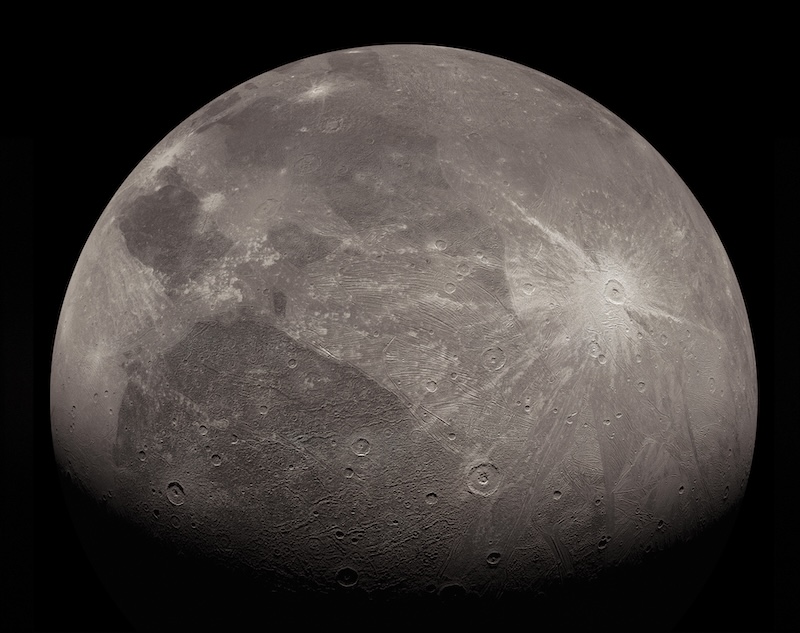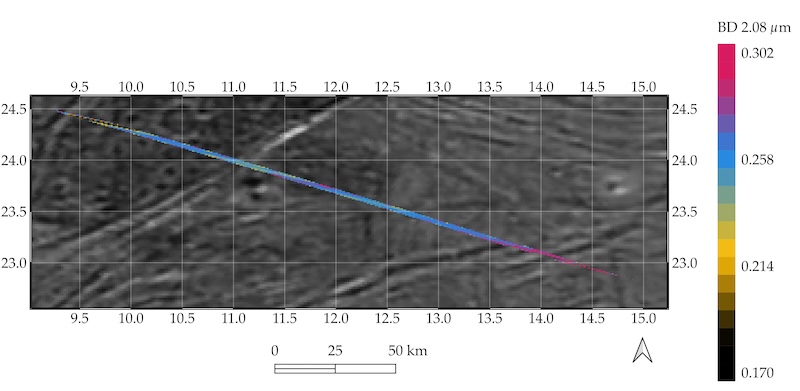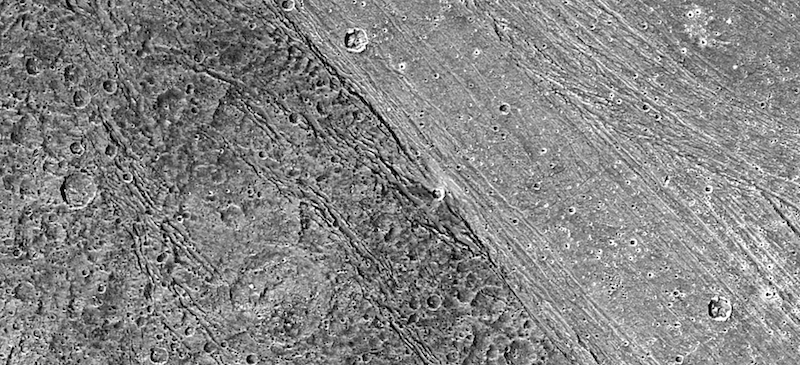
Ganymede is Jupiter’s largest moon, and it’s also the largest moon in the solar system. Like several other icy moons, scientists think that Ganymede has a deep ocean of liquid water beneath its outer ice crust. Now, NASA’s Juno spacecraft has found mineral salts and organic compounds on the surface of this large Jovian moon. The findings suggest that briny water has bubbled up to the surface from Ganymede’s subsurface ocean.
So Ganymede’s has signs of its ocean on its surface! NASA said on October 30, 2023, that this discovery will help scientists learn more about the composition of this moon’s hidden ocean. And that, in turn, will lead scientists to more understanding of how Jupiter’s large moon first formed.
Researchers in the U.S. and Italy published their peer-reviewed results in Nature Astronomy on October 30.
The 2024 lunar calendars are here! Best Christmas gifts in the universe! Check ’em out here.
A close flyby of Ganymede
Juno conducted a close flyby of Ganymede on June 7, 2021, coming within 650 miles (1,046 km) of the icy surface. Juno’s Jovian InfraRed Auroral Mapper (JIRAM) spectrometer acquired infrared images and infrared spectra. In general, mission scientists primarily use JIRAM to peer deep into Jupiter’s atmosphere. They have also used it, however, to study the surfaces of Io, Europa, Ganymede and Callisto.
And, in fact, the resolution of the infrared spectroscopy during the flyby was impressive, better than 0.62 miles (1 km) per pixel. Juno found a variety of surface materials, including hydrated sodium chloride, ammonium chloride, sodium bicarbonate and maybe also aliphatic aldehydes.
Federico Tosi is a Juno co-investigator at the National Institute for Astrophysics in Rome, Italy, and lead author of the new paper. He said:
The presence of ammoniated salts suggests that Ganymede may have accumulated materials cold enough to condense ammonia during its formation. The carbonate salts could be remnants of carbon dioxide-rich ices.
Watery brines
As the paper explained, the composition and distribution of the salts and organics suggests that they originated from within Ganymede (making them endogenous, or endogenic). In fact, they most likely came to the surface in watery brines:
The composition and spatial distribution of these salts and organics suggest that their origin is endogenic, resulting from the extrusion of subsurface brines, whose chemistry reflects the water–rock interaction inside Ganymede.
In addition, this result is reminiscent of another study that was published last month, showing that carbon-dioxide ice on the surface of Europa came from inside the moon instead of from an external source (exogenous).

Magnetic field protects brines
So, how do the scientists know that the salts and organics came from below as brines, instead of being created on the surface somehow? One big clue comes from Ganymede’s magnetic field. The magnetic field shields the moon’s surface along the equator up to about 40 degrees latitude. More specifically, the magnetic field blocks electrons and ions that come from Jupiter’s own and more powerful magnetic field. Those electrons and ions can easily damage the mineral salts and organics.
In 2021, during the flyby, Juno’s JIRAM instrument studied Ganymede’s surface from latitudes 10 degrees north to 30 degrees north and longitudes -35 degrees east to 40 degrees east. Those areas include the moon’s characteristic dark and bright regions. Those latitudes are protected by the magnetic field. And – surprise – that is where the salts and organics were primarily found. Scott Bolton, Juno’s principal investigator at the Southwest Research Institute in San Antonio, Texas, said:
We found the greatest abundance of salts and organics in the dark and bright terrains at latitudes protected by the magnetic field. This suggests we are seeing the remnants of a deep ocean brine that reached the surface of this frozen world.
Originally, evidence for Ganymede’s magnetic field first came when the Hubble Space Telescope observed the moon in ultraviolet (UV) light in 1998 and 2010. Images from both observations revealed an aurora zone on Ganymede. This was a sign that the large moon has a permanent magnetic field, produced by an iron core.

Water vapor on Ganymede
Also, in 2021, astronomers using archival data from Hubble found the first evidence of water vapor on Ganymede. Using the old data along with new data, the researchers measured the amount of atomic oxygen in the moon’s tenuous atmosphere. What they found was that the moon Ganymede has hardly any atomic oxygen. In essence, this finding seemed to upend their explanation for differences in the UV auroras.
But then, they looked more closely at where the UV auroral displays were on Ganymede. As it turned out, the locations of Ganymede’s auroras correlated with where they’d expect to find water in Ganymede’s atmosphere, if the moon was releasing water vapor.
Bottom line: NASA’s Juno spacecraft has found salts and organics on Jupiter’s largest moon, Ganymede. They suggest that watery brines came up to the surface from deep below.
Source: Salts and organics on Ganymede’s surface observed by the JIRAM spectrometer onboard Juno
Learn more about the Juno mission
Read more: See 1st new images of Ganymede in over 20 years
Read more: Webb telescope provides unique view of 2 Jupiter moons











